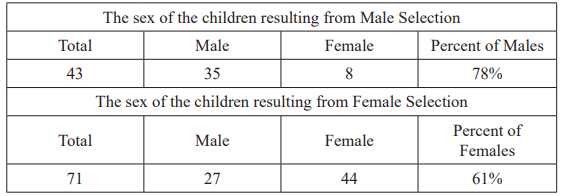Altering the Sex Ratio Expressed As the Proportion of Males to Females Using Albumin-Separated Sperm
Author'(s): Andrew Y. Silverman, M.D., Ph.D.* and Bernadette Braniff Ryan, R.N.
40 Sunnyside Way, New Rochelle, NY 10804, US.
*Correspondence:
Andrew Y. Silverman, M.D., Ph.D., 40 Sunnyside Way, New Rochelle, NY 10804, Tel: 212-327-1809; Fax: 914-633-1554; E-mail: aysilverman@gmail.com.
Received: 13 August 2018 Accepted: 02 September 2018
Citation: Andrew Y. Silverman, Bernadette Braniff Ryan. Altering the Sex Ratio Expressed As the Proportion of Males to Females Using Albumin-Separated Sperm. Gynecol Reprod Health. 2018; 2(5): 1-2.
Abstract
Statement of the Problem: The sex ratio of boys to girls at birth in the human population is 1058 boys to 100 girls [1]. Does this ratio change with the insemination of selected albumin-separated sperm? The analysis of the births born to couples who underwent sperm separation to influence the sex outcome of their child was carried out from 1990 through 2004.
Methodology: Male or female sperm selection was carried out [2], and an intrauterine insemination was performed of the selected sperm as previously reported.
Keywords
Introduction
Couples presented to my practice (Dr. Silverman) for gender selection of their next child. They were counseled as to the risks and benefits undergoing the procedure prior to initiating the process. Those couples choosing a daughter were provided a prescription for chlomiphene citrate to take on cycle days 5 to 9, while those couples choosing a son were not given medication. In the cycle of the procedure, ovulation was predicted by urine LH testing, and the process was carried out prior to ovulation. Briefly the ejaculates were diluted, centrifuged, and the pellet suspended in Tyrode's salt solution. For those couples desiring a female, X sperm were selected [3], and for those couples desiring a male, Y sperm were selected [4]. After Insemination with an intrauterine catheter, the women rested for 10 minutes, and were discharged to home. Those women with a positive pregnancy test were referred back to their obstetrician. Follow up after delivery was made by phoning the patient.
Results
The results are presented in Figure 1 for both male and female selection. A total of 43 children were born to couples selecting for a male, and a total of 71 children (which included six sets of twins) were born to couples selecting for a female.

Conclusion and Significance
The expected sex ratio at birth is 105 boys are born for every 100 females [1]. Chi Square analysis reveals that the sex ratio of children born after undergoing the sperm selection process are statistically increased over the expected ratio. It is interesting that almost twice as many couples wanted a daughter compared to a son. This is possibly due to the expected ratio of the greater number of males to females.
References
- Maconochie N and Roman E. Sex ratios: are there natural variations within the human populations? Br J Obstet Gynaecol. 1997; 104: 1050-1053.
- Claassens OE, Oosthuizen CJJ, Brusnicky J, et Fluorescent in situ hybridization evaluation of human Y-bearing spermatozoa separated by albumin density gradients. Fertility Sterility. 1995; 63: 417-418.
- Silverman AY, Stephens SR, Drouin MT, et Female sex selection using clomiphene citrate and albumin separation of human sperm. Human Reproduction. 2002; 17: 1254-1256.
- Beernink FJ, Dmowski WP, Ericsson R. Sex preselection through albumin separation of sperm. Fertility and Sterility. 1993; 59: 382-386.